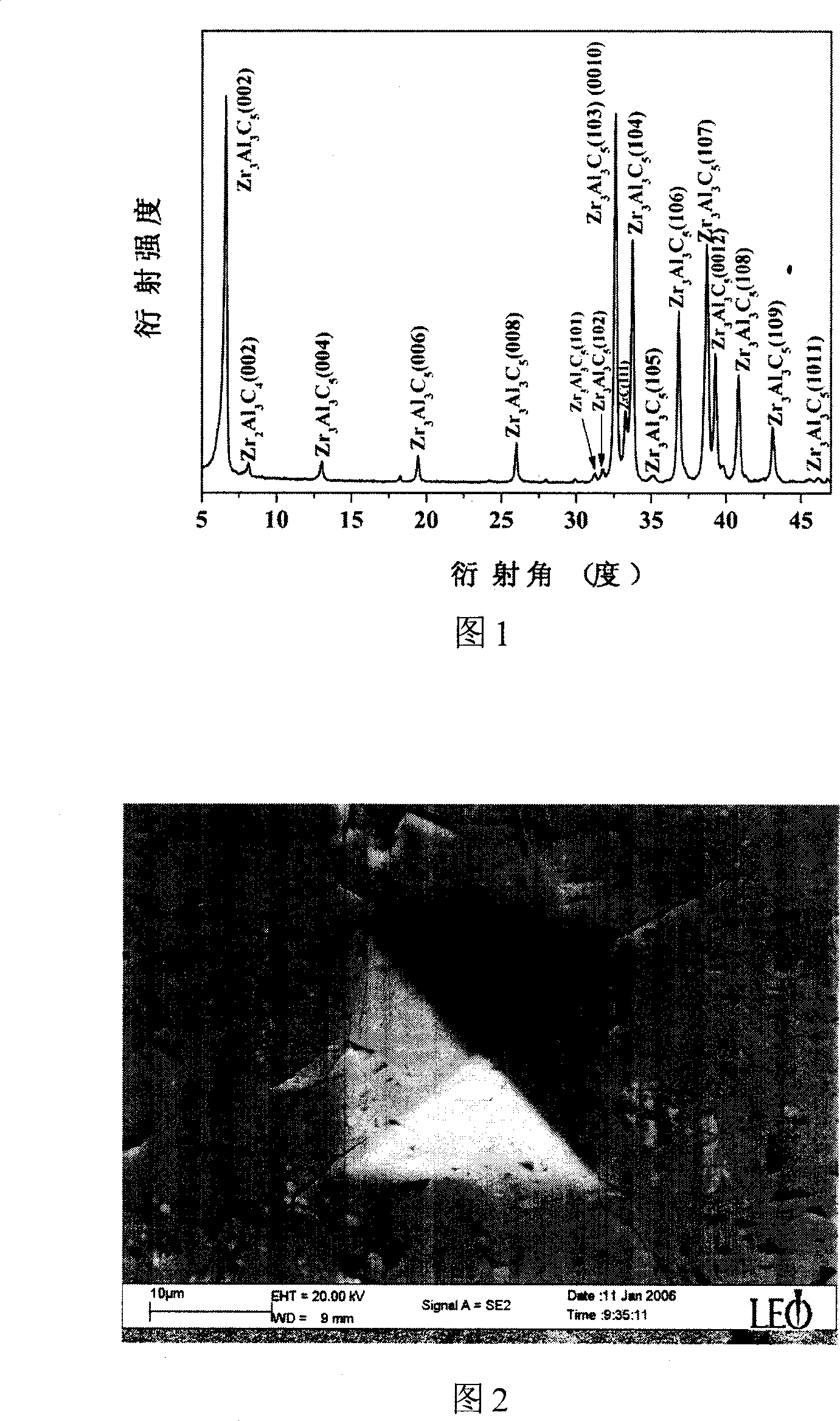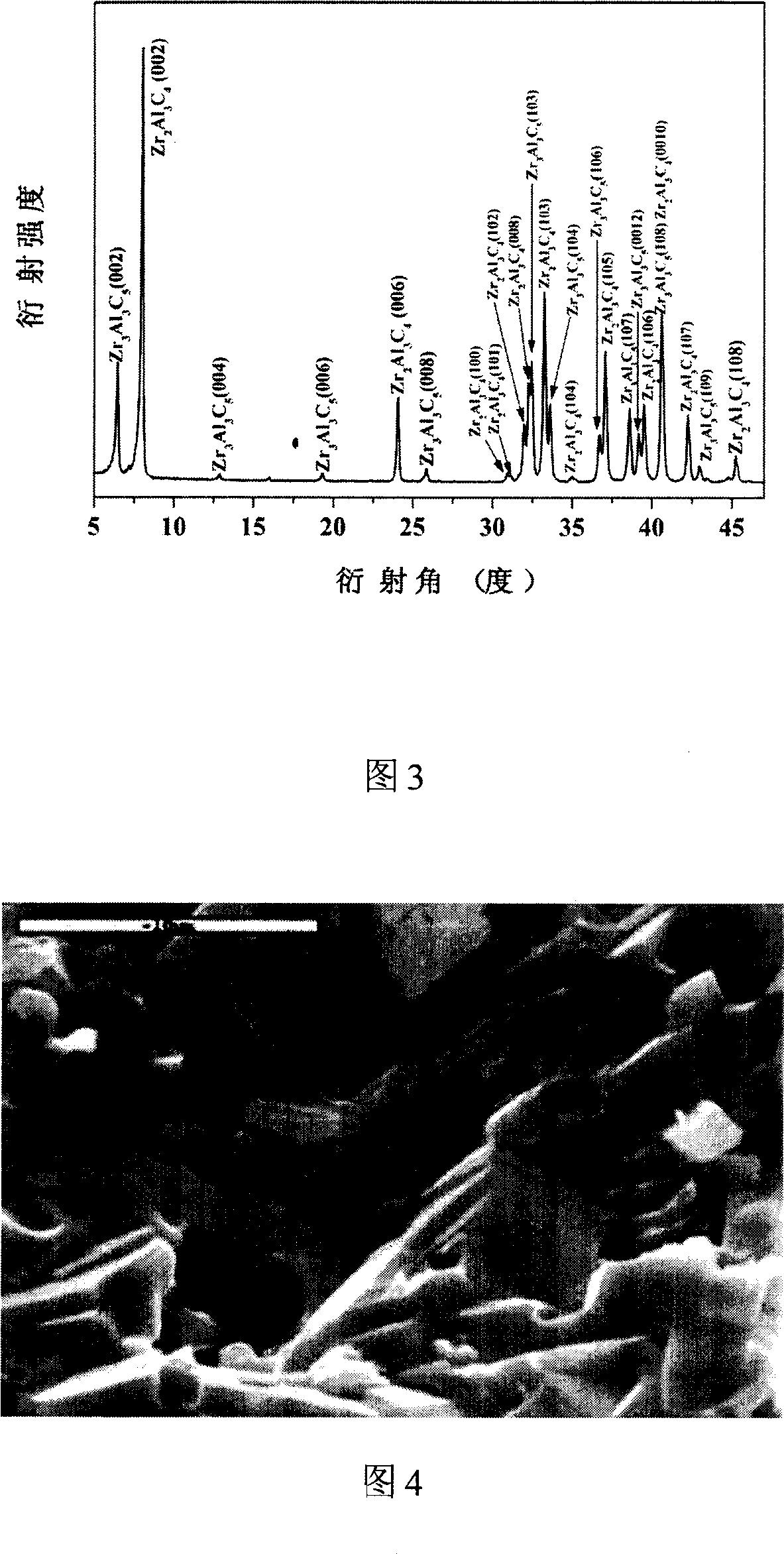Method for preparing zirconium-aluminium-carbon ceramic cube material by in-situ reaction heat-pressing
A zirconium-aluminum-carbon ceramic and in-situ reaction technology is applied in the field of preparing zirconium-aluminum-carbon ceramic bulk materials by in-situ reaction hot pressing, which can solve the problems of high sintering temperature, complicated process, and unfavorable material mechanical properties.
- Summary
- Abstract
- Description
- Claims
- Application Information
AI Technical Summary
Problems solved by technology
Method used
Image
Examples
Embodiment 1
[0021] The raw materials are 100.00 grams of Zr powder, 29.55 grams of Al powder and 26.33 grams of C powder with a particle size of about 300 meshes, ball milled for 10 hours, cold pressed into a cake shape under a pressure of 15 MPa, put into a graphite mold, and pass through an inert gas ( Argon) was used as the protective gas in a hot-pressing furnace at a rate of 10°C / min to 1700°C for in-situ reaction hot-pressing for 1 hour, and the hot-pressing pressure was 30MPa. The main reaction product obtained is analyzed by X-ray diffraction as Zr 3 Al 3 C 5 . The corresponding X-ray diffraction patterns and scanning electron micrographs are listed in accompanying drawings 1-2 respectively. The reaction product had a Vickers hardness of 12 GPa (with a load of 10 N), a dynamic Young's modulus and a shear modulus of 334 GPa and 142 GPa, respectively.
Embodiment 2
[0023] The raw materials are 100.00 grams of Zr powder, 39.40 grams of Al powder and 21.94 grams of C powder with a particle size of about 200 meshes. They are ball-milled for 20 hours, cold-pressed into cakes under a pressure of 10 MPa, and put into graphite molds. In a hot-pressing furnace with a protective gas, the temperature was raised to 1600° C. at a rate of 20° C. / min for in-situ reaction hot-pressing for 4 hours, and the hot-pressing pressure was 40 MPa. The main reaction product obtained is analyzed by X-ray diffraction as Zr 3 Al 3 C 5 and Zr 2 Al 3 C 4 two-phase composite materials. The corresponding X-ray diffraction patterns are listed in accompanying drawing 3.
Embodiment 3
[0025] The raw material adopts 100.00 grams of Zr powder, 44.33 grams of Al powder and 32.91 grams of C powder with a particle size of about 400 meshes, ball milled for 15 hours, cold-pressed into a cake shape under a pressure of 20 MPa, and packed into a graphite mold. for 10 -2 Pa) in a hot-pressing furnace at a rate of 15° C. / min to 1800° C. for in-situ reaction hot-pressing for 0.5 hour, and the hot-pressing pressure is 30 MPa. The main reaction product obtained is analyzed by X-ray diffraction as Zr 2 Al 3 C 4 . The corresponding fracture scanning electron micrographs are shown in Figure 4, with Zr 3 Al 3 C 5 Compared to Zr 2 Al 3 C 4 There are more obvious layered features on the cross-section.
PUM
| Property | Measurement | Unit |
|---|---|---|
| Granularity | aaaaa | aaaaa |
| Shear modulus | aaaaa | aaaaa |
| Granularity | aaaaa | aaaaa |
Abstract
Description
Claims
Application Information
 Login to View More
Login to View More - R&D
- Intellectual Property
- Life Sciences
- Materials
- Tech Scout
- Unparalleled Data Quality
- Higher Quality Content
- 60% Fewer Hallucinations
Browse by: Latest US Patents, China's latest patents, Technical Efficacy Thesaurus, Application Domain, Technology Topic, Popular Technical Reports.
© 2025 PatSnap. All rights reserved.Legal|Privacy policy|Modern Slavery Act Transparency Statement|Sitemap|About US| Contact US: help@patsnap.com


